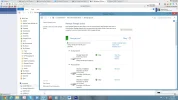What is going on here? Total madness?
Link Removed
Link Removed
First, please let me apologize for the mass of wires, general techno geek junk, and other no-no’s like a can of diet Pepsi right next to my StarTech 4-port USB3 drive bay. Once I did some extensive reading about Storage Pools in Windows 8 RTM, total obsession took over. My test system now includes eight solid state drives, three traditional Seagate 1.5TB SATA2 drives connected via USB3, a 2.5” 750GB Western Digital laptop HD, and a USB3 Western Digital 2TB Passport drive, usually reserved for backups (I have another one coming so that I can run Storage Pools on my laptops once Windows 8 retails).
What are Storage Pools?
Well, first of all, they’re not even called Storage Pools. They’re called Storage Spaces. But these spaces form pools of resiliency that protect your data nearly as good as RAID; in many ways, better. While RAID is designed specifically for systems with expensive controller cards and controlled, duplicate storage, Storage Spaces allow you to simply continue adding hard drives, forever. According to Microsoft, they tested hundreds of hard drives, without apparent difficulty, using this new technology.
Apparently, Server 8, which will feature NTFS’ replacement ReFS (Resilient File System), will also use Storage Spaces. This will save large businesses millions of dollars in overhead costs if implemented properly in PowerShell.
But the great part is that any Windows 8 Client user will be able to benefit from Storage Spaces as well. For example, I have about 20TB of storage connected to my system right now, and I have assigned about 6TB for use. This gives me 18TB of resiliency in case there are two simultaneous drive failures. I can continue to use my Storage Space as if those drives were never there, until I replace said drives with better ones or duplicates.
Depending on how much space I am using, they can even be bigger or smaller.
The possibility of Storage Spaces has brought me back to the insanity stage of computing I was at years ago, when I first started as a simple technician. I am starting to think about how I will offer backup solutions with this technology, and I already know how. The only problem with Storage Spaces? You can’t install Windows 8 on them just yet. When not protecting your data clockwise, these pools are purported to be so good that RAID-0 and RAID-10 configurations may actually slow them down. Of course, in PowerShell, you can designate what drives do what, and that, in and of itself, will be an incredible feature for advanced users using a combination of SSDs, SATA2, SATA3, USB3, and SCSI technology.
Find out more about this amazing technology from Microsoft over at Technet and MSDN here. After some extensive testing that is not even done yet, I would consider it a serious replacement to RAID (Random Array of Independent Disks). You can even use Storage Spaces to load up Hyper-V virtual hard disks (VHDs). Suddenly, storage has become unlimited, and in some strange way, you are your own cloud again.
Just avoid tangled wires, CD trays, portable air canisters, and your car keys getting lost inside your chassis!
Link Removed
Configuring Storage Overview
Link Removed
Link Removed
First, please let me apologize for the mass of wires, general techno geek junk, and other no-no’s like a can of diet Pepsi right next to my StarTech 4-port USB3 drive bay. Once I did some extensive reading about Storage Pools in Windows 8 RTM, total obsession took over. My test system now includes eight solid state drives, three traditional Seagate 1.5TB SATA2 drives connected via USB3, a 2.5” 750GB Western Digital laptop HD, and a USB3 Western Digital 2TB Passport drive, usually reserved for backups (I have another one coming so that I can run Storage Pools on my laptops once Windows 8 retails).
What are Storage Pools?
Well, first of all, they’re not even called Storage Pools. They’re called Storage Spaces. But these spaces form pools of resiliency that protect your data nearly as good as RAID; in many ways, better. While RAID is designed specifically for systems with expensive controller cards and controlled, duplicate storage, Storage Spaces allow you to simply continue adding hard drives, forever. According to Microsoft, they tested hundreds of hard drives, without apparent difficulty, using this new technology.
Apparently, Server 8, which will feature NTFS’ replacement ReFS (Resilient File System), will also use Storage Spaces. This will save large businesses millions of dollars in overhead costs if implemented properly in PowerShell.
But the great part is that any Windows 8 Client user will be able to benefit from Storage Spaces as well. For example, I have about 20TB of storage connected to my system right now, and I have assigned about 6TB for use. This gives me 18TB of resiliency in case there are two simultaneous drive failures. I can continue to use my Storage Space as if those drives were never there, until I replace said drives with better ones or duplicates.
Depending on how much space I am using, they can even be bigger or smaller.
The possibility of Storage Spaces has brought me back to the insanity stage of computing I was at years ago, when I first started as a simple technician. I am starting to think about how I will offer backup solutions with this technology, and I already know how. The only problem with Storage Spaces? You can’t install Windows 8 on them just yet. When not protecting your data clockwise, these pools are purported to be so good that RAID-0 and RAID-10 configurations may actually slow them down. Of course, in PowerShell, you can designate what drives do what, and that, in and of itself, will be an incredible feature for advanced users using a combination of SSDs, SATA2, SATA3, USB3, and SCSI technology.
Find out more about this amazing technology from Microsoft over at Technet and MSDN here. After some extensive testing that is not even done yet, I would consider it a serious replacement to RAID (Random Array of Independent Disks). You can even use Storage Spaces to load up Hyper-V virtual hard disks (VHDs). Suddenly, storage has become unlimited, and in some strange way, you are your own cloud again.
Just avoid tangled wires, CD trays, portable air canisters, and your car keys getting lost inside your chassis!
Link Removed
Configuring Storage Overview




